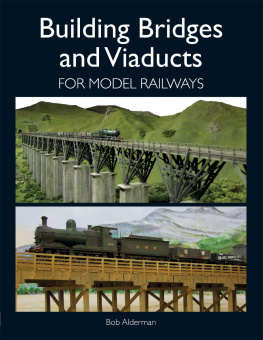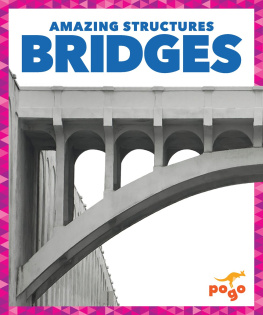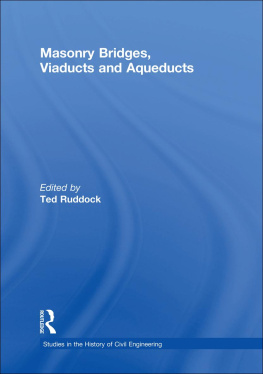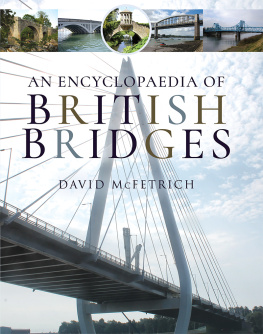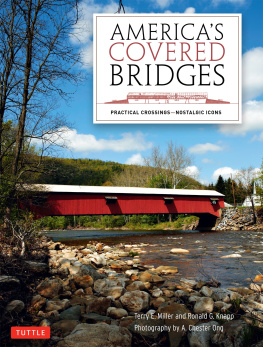Building Bridges
and Viaducts
FOR MODEL RAILWAYS
Bob Alderman

THE CROWOOD PRESS
First published in 2014 by
The Crowood Press Ltd
Ramsbury, Marlborough
Wiltshire SN8 2HR
www.crowood.com
This e-book first published in 2014
Bob Alderman 2014
All rights reserved. No part of this publication may be reproduced or transmitted in any form or by any means, electronic or mechanical, including photocopy, recording, or any information storage and retrieval system, without permission in writing from the publishers.
British Library Cataloguing-in-Publication Data
A catalogue record for this book is available from the British Library.
ISBN 978 1 84797 819 6
Disclaimer
The author and the publisher do not accept any responsibility in any manner whatsoever for any error or omission, or any loss, damage, injury, adverse outcome, or liability of any kind incurred as a result of the use of any of the information contained in this book, or reliance upon it.
Acknowledgements
I have had help from many friends and others in the preparation of this book. In particular to Graham Tombs for his help in going back to his day job to give me practical guidance on various structures; Dave Sapp for his holiday diversion for the Welsh Highland Railway pictures; and Geoff Byman for his input on the garden railway structures. Others too who have kindly supplied photographs where I have been unable to access some bridges. Finally to those who presented me with their work at model railway exhibitions that I was able to photograph.
CONTENTS
INTRODUCTION
Bridges and viaducts have been a necessity for railway engineers from the beginning of railways. Natural features like valleys and rivers have to be crossed; man-made features like roads and canals have to be crossed too. Sometimes the construction of the railway required bridges for roads above railway cuttings or below embankments.
The worlds first railway bridge was the Causey Arch near Stanley, County Durham a masonry arch built in 172526 to carry a plateway over the Bobgins Burn. The preserved line of the Tanfield Railway is nearby and Beamish Open Air Museum is close. The first railway viaduct was in Blaenafon, South Wales though its remains have been lost.
The earliest railway engineers worked in stone, wood and cast and wrought iron; steel came later to railway structures. Many of these steel structures are still present and in use.
Wood generally has not had the same longevity. Brunel used it extensively in viaducts to cross Cornish valleys. All his viaducts have been replaced in masonry and brick, leaving only the plinths that supported the timber trusses. However, a fine later timber structure still exists in use across the estuary of the Afon Mawddach, Barmouth, Gwynedd.
Early cast-iron structures have not lasted either. Often they failed, as the material was not used to its best advantage. One early structure is the Gaunless Bridge constructed by Robert Stephenson, once part of the Stockton and Darlington Railway at West Auckland, which has now been re-erected outside the National Railway Museum, York. Later ones remain in use and are generally of monumental proportions. Some part cast-iron bridges remain: the ironwork left from an earlier period used as decoration and a newer internal structure used for load-carrying.
Steel is widely used and can be seen everywhere. It is commonly used in the simple plate-girder bridge. Here steel sections and plates are riveted together to form a larger girder or sections joined to make up truss-girder bridges. A modern application is the welding of plate to form box girder bridges.
Widely used in the present is reinforced concrete; these structures often show great simplicity of form.
BRIDGE TYPES
MASONRY AND BRICK
There is regional variation following house styles for many of the masonry and brick structures, though they all have the same basic construction. In addition, the local geology has much to do with the variation. The local stone will have a characteristic colour and texture. Similarly the clays available for brickmaking each imparted different colours. In the case of bricks, some national uniformity crept in once mass production was undertaken and especially with the production of the hard engineering bricks, Staffordshire Blue being very common.
STEEL
Steel structures are generally consistent throughout the country. This is down to the engineering principles that are used to fabricate a structure to span a gap. Plate-girder bridges are probably the most common. Truss-girder bridges are less so and have more specific applications. The Dapol Girder Bridge is an over-simplified version of one of these.
IRON
Iron bridges are immediately recognizable from their monumental appearance. The usual form is a segmental arch and is often highly decorated, exploiting this feature of cast iron.
CONCRETE
Again modern concrete construction shows great consistency across the country. The sizes range from small occupation crossings to bridges carrying multiple tracks across major roads.
MODELS
I have set out to give examples of many of these structures, which are by no means all-inclusive. They are illustrated and described in the following chapters. I believe that if there is some understanding of how something is made, a better model will result. I have made several of these structures with stepby-step illustrations. They have been constructed in plasticard sheet, embossed and plain, and plastic sections. This is my preferred medium for structures it can be readily cut, joined and shaped.
All but one of the models has been made in 7mm: 1ft scale. Partly because this is the scale I usually work in, but it also makes the models large enough to illustrate the construction. The methods I have used should read across to the smaller scales too.
The models have been made and photographed as the build progressed. This has resulted in odd corners of my workshop turning up in the background. I trust this will not be too distracting!
Other models are illustrated from commercial sources and some that other modellers have made.

CHAPTER ONE
PROTOTYPE DESCRIPTIONS
MASONRY ARCH BRIDGES AND VIADUCTS
Arch bridges and viaducts fall into three main types: semi-circular or Roman arch, segmental (a segmental arch is part of a circle) or elliptical. Elliptical arches seem to be rare in viaducts, though, simple curves being preferred. All types can be found around the system.
The main parts of a masonry arch are:
Abutments that support the ends of the arch providing the base for the arch or, for a viaduct, a column or pier. |

